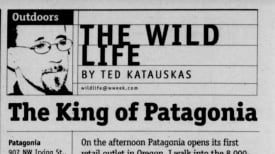Last week’s archive story focused on the 20th anniversary of the Sept. 11 attacks, highlighting WW’s coverage in the weeks after.
In a bizarre, unrelated happenstance, that week also saw the opening of the city’s first Patagonia store. Then-WW outdoors columnist Ted Katauskas described his initial impressions of the space, which included spotting Patagonia’s legendary founder Yvon Chouinard standing at the top of the stairs, fondly stroking an anvil.
On the afternoon Patagonia opens its first retail outlet in Oregon, I walk into the 8,000-square-foot store and find Yvon Chouinard standing at the top of the stairs, fondly stroking an anvil on display near a wall-mounted tailgate from a VW bus. The place is jam-packed, but just about everybody ignores Patagonia’s legendary founder —probably because the elfin, 64-inch-tall 62-year-old looks more like a reserved English professor than a world-famous alpinist.
Chouinard isn’t most people’s idea of a giant. But he has been one. And still is.
Before Chouinard introduced the world to Patagonia’s stylish brand of outdoor armor in the early 1970s, he reveled in the life of the itinerant dirtbag climber, criss-crossing the world with his trusty portable forge, selling scrap-metal pitons for $1.50 apiece while pioneering some of the world’s most notorious first ascents (like his epic 10-day conquest of El Capitan’s 3,000-foot North American Wall in 1964).
In his 20s, Chouinard spent a summer living in an abandoned incinerator while guiding in the Tetons. He’s eaten porcupines and squirrels for dinner, carved out steps with a spoon on a snow-encrusted slope in the Sierras, and once weathered a month-long storm in an ice cave on Argentina’s Mount Fitzroy, starving, shivering in a soaked and useless down sleeping bag. Back then, when people ventured outdoors, they expected to suffer. Or at least be uncomfortable.
But not anymore. And Chouinard, now a millionaire many times over, feels responsible. As the registers at the boutique store in Ecotrusfs ever-so-green new Pearl District building beep away, the aging rock icon invites me to sit down for a chat in the store’s library. He slumps beside me in a reproduction of a Timberline Lodge couch, working himself into an ever-deepening funk.
“A lot of people who buy Patagonia gear live pretty boring lives,” observes Chouinard, who spent a summer in the 1980s teaching ice climbing on Mount Hood for Portland State University. “You know, they rationalize the technical jacket, thinking that someday they’re gonna lose 30 pounds, get in shape and go climb Mount Rainier. That’s OK. You need to have dreams.”
But unless your dreams encompass a winter summit attempt on Denali, you probably don’t really need that poppy-red, $460 Ice Nine with its three-layer Gore-Tex composite fabric and water-resistant pit zips. “The thought of getting your underarms wet is unacceptable,” he says with contempt.
“In fact, the whole idea of getting wet is completely horrendous to people, which is ridiculous. This is the Northwest. When you go outside, you should get wet. What’s happened is that there’s too much gear, and it’s too good.
And now people think that they need to protect themselves from this voracious thing called nature. They’re scared to death of the wilderness.”
I ask Chouinard if he’s beginning to feel like a bitter old fart. He just laughs. After all, not many senior citizens can claim to have just nailed a seven-pitch first ascent in the Wind River Range. For the record, the jacket he wore didn’t have pit zips.
